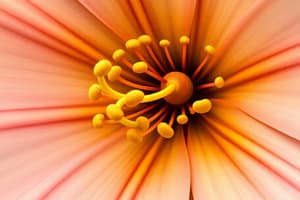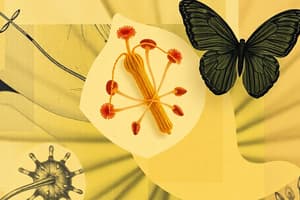Podcast
Questions and Answers
How does the evolutionary process of carpel development most accurately unfold?
How does the evolutionary process of carpel development most accurately unfold?
- Starts as a modified leaf with sporangia, evolving through inward curling and fusion of leaf edges, ultimately forming a chambered ovary. (correct)
- Involves the fusion of microsporangia to form an ovule.
- Originates from the progressive reduction of the carpel's reproductive capabilities.
- Begins as separate pistils that fuse into a leaf-like structure with sporangia.
Consider a flower exhibiting apocarpy. Which structural characteristic would definitively identify its gynoecium?
Consider a flower exhibiting apocarpy. Which structural characteristic would definitively identify its gynoecium?
- Multiple distinct (unfused) carpels. (correct)
- A single pistil composed of fused carpels.
- A single carpel forming the entire pistil.
- A gynoecium lacking both carpels and pistils.
How does the arrangement of stamens described as 'obdiplostemonous' differ significantly from a 'diplostemonous' arrangement?
How does the arrangement of stamens described as 'obdiplostemonous' differ significantly from a 'diplostemonous' arrangement?
- Obdiplostemonous stamens are sterile, diplostemonous are fertile.
- Obdiplostemonous stamens have the outer whorl opposite the petals, while diplostemonous stamens have the outer whorl alternating with the petals. (correct)
- Obdiplostemonous stamens are fused at the base, diplostemonous are not.
- Obdiplostemonous stamens are arranged in a single whorl, while diplostemonous stamens are in two.
In the context of floral symmetry, what key characteristic distinguishes a flower with bilateral (zygomorphic) symmetry from one with radial (actinomorphic) symmetry?
In the context of floral symmetry, what key characteristic distinguishes a flower with bilateral (zygomorphic) symmetry from one with radial (actinomorphic) symmetry?
If a botanist describes a flower as 'epigynous,' what does this indicate about the position of the ovary relative to other floral parts?
If a botanist describes a flower as 'epigynous,' what does this indicate about the position of the ovary relative to other floral parts?
How does a 'spadix' inflorescence, characteristic of plants in the Araceae family, differ structurally from a typical 'raceme'?
How does a 'spadix' inflorescence, characteristic of plants in the Araceae family, differ structurally from a typical 'raceme'?
How would you differentiate between a flower described as 'gamopetalous' and one described as 'polypetalous'?
How would you differentiate between a flower described as 'gamopetalous' and one described as 'polypetalous'?
What evolutionary advantage does dichogamy provide to flowering plants, and how does protandry specifically contribute to this advantage?
What evolutionary advantage does dichogamy provide to flowering plants, and how does protandry specifically contribute to this advantage?
How does an 'involucre' contribute to the structure and function of an inflorescence, particularly in compound umbels like those found in the Apiaceae family?
How does an 'involucre' contribute to the structure and function of an inflorescence, particularly in compound umbels like those found in the Apiaceae family?
Considering stamen evolution, what is the significance of the reduction of the leaflike portion of the stamen structure over evolutionary time?
Considering stamen evolution, what is the significance of the reduction of the leaflike portion of the stamen structure over evolutionary time?
In a flower with heterostyly, how do 'thrum-eyed' morphs differ from 'pin-eyed' morphs in terms of reproductive organ placement, and what is the adaptive significance of this difference?
In a flower with heterostyly, how do 'thrum-eyed' morphs differ from 'pin-eyed' morphs in terms of reproductive organ placement, and what is the adaptive significance of this difference?
A plant is described as having a 'determinate' inflorescence. What does this indicate about the timing and location of its flower development?
A plant is described as having a 'determinate' inflorescence. What does this indicate about the timing and location of its flower development?
How is ‘connation’ specifically expressed in floral structures?
How is ‘connation’ specifically expressed in floral structures?
How might the evolution of flower parts contribute to plant adaptation, especially considering the interplay between floral structure and sexual reproduction?
How might the evolution of flower parts contribute to plant adaptation, especially considering the interplay between floral structure and sexual reproduction?
What is the functional significance of a flower being 'apetalous', and in what kind of environmental conditions might this trait be particularly adaptive?
What is the functional significance of a flower being 'apetalous', and in what kind of environmental conditions might this trait be particularly adaptive?
How does the structural definition of a pistil relate to that of a carpel, particularly when describing a gynoecium that is 'compound'?
How does the structural definition of a pistil relate to that of a carpel, particularly when describing a gynoecium that is 'compound'?
How are floral whorls categorized, and what evolutionary implications arise from a flower described as having incomplete floral whorls?
How are floral whorls categorized, and what evolutionary implications arise from a flower described as having incomplete floral whorls?
What factors might cause a plant to undergo selfing, and how does self-incompatibility counteract this?
What factors might cause a plant to undergo selfing, and how does self-incompatibility counteract this?
What role do microsporangia play in stamen evolution?
What role do microsporangia play in stamen evolution?
In floral morphology, what distinguishes a 'free-central' placentation from an 'axile' placentation?
In floral morphology, what distinguishes a 'free-central' placentation from an 'axile' placentation?
Flashcards
Stamen
Stamen
The male reproductive part of a flower, including the filament and anther.
Carpel/Pistil/Gynoecium
Carpel/Pistil/Gynoecium
The female reproductive organ of a flower, including the ovary, style, and stigma.
Sepals
Sepals
Outermost whorl; typically green; protect the developing flower bud.
Petals
Petals
Signup and view all the flashcards
Receptacle
Receptacle
Signup and view all the flashcards
Anther
Anther
Signup and view all the flashcards
Filament
Filament
Signup and view all the flashcards
Stigma
Stigma
Signup and view all the flashcards
Style
Style
Signup and view all the flashcards
Ovary
Ovary
Signup and view all the flashcards
Ovule
Ovule
Signup and view all the flashcards
Floral Whorl
Floral Whorl
Signup and view all the flashcards
Corolla
Corolla
Signup and view all the flashcards
Calyx
Calyx
Signup and view all the flashcards
Perfect Flower
Perfect Flower
Signup and view all the flashcards
Imperfect Flower
Imperfect Flower
Signup and view all the flashcards
Radial/Actinomorphic
Radial/Actinomorphic
Signup and view all the flashcards
Bilateral/Zygomorphic
Bilateral/Zygomorphic
Signup and view all the flashcards
Polypetalous
Polypetalous
Signup and view all the flashcards
Gamopetalous
Gamopetalous
Signup and view all the flashcards
Study Notes
- A flower contains male and female reproductive parts.
Flower Parts
- Stamen is the male reproductive part.
- Carpel or pistil is the female reproductive part.
- Filament and anther are parts of the stamen.
- Stigma, style, and ovary are parts of the carpel.
- Petals together form the corolla.
- Sepals together form the calyx.
- The ovule forms within the ovary.
- The receptacle is located at the base of the flower.
Floral Whorls
- Sepals and petals are accessory parts.
- Stamen/androecium and carpel/pistil/gynoecium are vital parts.
Carpel Evolution
- Begаn as a modified leaf with sporangia.
- Leaf edges curled inwards and fused through evolution.
- Three carpels fused to form a three-chambered ovary.
Stamen Evolution
- The leaflike portion of the stamen progressively reduced.
- Only the microsporangia remained.
Stamen vs Carpel
- Stamen is the male fertilizing organ, consisting of a pollen-containing anther and a filament.
- Carpel is the female reproductive organ, consisting of an ovary, stigma, and usually a style.
- Stamen is the male reproductive structure, while carpel is the female reproductive structure.
- Androecium refers to the collection of anthers and filaments (a stamen), gynoecium refers to a single set of the ovary, style, and stigma (a carpel).
- Stamen occurs surrounding the female reproductive structure, and carpel occurs at the center of the flower.
- Stamen produces pollen grains, while carpel produces ovules.
- Stamen releases pollen grains for pollination, and with carpel the stigma captures pollen grains.
- Pollen grains germinate, producing male gametes, and with carpel, ovules possess eggs inside the embryo sac.
Gynoecium, Pistil, Carpel
- Gynoecium refers to all female parts of a flower.
- Pistil is a structure consisting of the ovary, style(s), and stigma(s).
- Carpel is a conduplicate megasporophyll, and it can be a unit of pistil if the pistil is compound, with more than one carpel.
Gynoecium Terminology
- Monocarpous (single carpel) is termed a simple pistil; like avocado and most legumes
- Apocarpous (multiple distinct carpels) are termed simple pistils; like strawberry and buttercup
- Syncarpous (multiple connate carpels) are termed a compound pistil; like tulip and most flowers
Androecium
- Stamen parts include the anther, thecae, filament, and staminal disk.
- Types of stamen arrangements include tetradynamous and didynamous.
Connation
- Connation is the fusion of floral parts from the same whorl.
- Fused filaments form a staminal tube.
- Types of fused filaments arrangements include diadelphous and monadelphous.
- Anthers can be connate, or syngenesious.
Perianth fusion Examples
- Aposepalous/apopetalous means unfused.
- Synsepalous/sympetalous means fused.
Floral Variations
- Floral whorls may be complete (all 4 whorls are present) or incomplete (either/or are not present).
- Essential parts can be perfect (both stamen and pistil are present;hermaphroditic) or imperfect (either/or are not present).
- Symmetry can be radial/actinomorphic (2 equal halves; odd amounts) or bilateral/zygomorphic (dividing 2 equal halves only by medial cut through the central axis).
- Nature of the corolla can be polypetalous (many petals in one plant) or gamopetalous (fused petals).
- Flowers can be apetalous which means no petals.
- Ovary position can be perigynous, epigynous (ovary is covered with sepals), or hypogynous (more attached to the base).
- Arrangement of parts includes ovary superior (hypogynous or perigynous) or ovary inferior (epigynous).
- Placentation types include marginal, axile, parietal, free-central, basal, and apical.
Inflorescence
- Inflorescence is a collection/aggregation of flowers.
- A peduncle is the stalk of the inflorescence, while inflorescence axes are the branches of the inflorescence.
- A bract is a flower bract or inflorescence bract.
- A flower bract subtends an individual flower.
- Inflorescence bract subtends an entire inflorescence or an inflorescence axis.
- An Involucre is a group of inflorescence bracts subtending an entire inflorescence.
- A spathe is a specialized single inflorescence bract, which subtends an entire inflorescence with a spadix in Araceae.
- Inflorescence positions can be terminal or axillary.
- Inflorescence development can be determinate (terminal flower develops first) or indeterminate (basal flower develops first).
Indeterminate Inflorescences Types
- Raceme
- Panicle
- Spike
- Catkin
- Corymb
- Head
Determinate Inflorescences Types
- Dichasium
Specialized Inflorescences
- Spadix
Flower Variation Summary
- Four whorls: complete / incomplete
- Essential parts: perfect / imperfect
- Nature of corolla: polypetalous (free petals) / gamopetalous (fused petals) / apetalous (no petals)
- Symmetry: actinomorphic / zygomorphic
- Position of Ovary: superior / inferior
- Attachment of floral parts: Epi- / hypo- / perigynous
- Placentation: Marginal / axile / basal / free central / parietal
- Inflorescence: solitary / raceme / cyme / umbel / corymb / spike / panicle / catkin / spadix / composite
Flowers
- Important for sexual reproduction and also important for evolution
- Flowers produce variable offspring, creating diversity
- Variation is needed for natural selection to happen
- Being advantageous to an organism also requires being advantageous to another organism.
- Most plants have both sexes on one body.
Selfing
- Selfing is indreeding.
- Only 10-15% of flowering plants are selfers.
- Selfers rely on self-compatibility.
- Selfing can be be accompanied by structural mechanisms.
- Some species are obligate selfers with no choice.
Methods to Prevent Self-Pollination
- Dichogamy is when anthers and stigmas mature at different times; includes protandry and protogyny.
- Plants can have unisexual flowers; one-gendered plant.
- Incompatibility when plants produce a chemical in the stigma to prevent germination of their own pollens.
- Heterostyly exists as thrum-eyed (anthers high up and stigmas low down) and pin-eyed (stigmas high up and anthers low down).
Studying That Suits You
Use AI to generate personalized quizzes and flashcards to suit your learning preferences.




